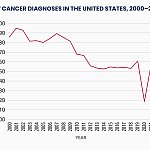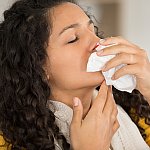
A synthetic chemical used in many household products is being linked to a potential increase in cardiovascular disease risk.
A study published on April 28 in the journal
The researchers focused on a family of chemicals known as phthalates, which are used to strengthen the plastic used in an array of products from children’s toys to shampoo, soap, air fresheners, perfume, vinyl flooring, garden hoses, clothing, plastic food wrappings, and containers.
In particular, the scientists looked at the risks associated with a phthalate known as di(2-ethylhexyl)phthalate, or DEHP, in 200 countries and territories worldwide.
They concluded that this type of phthalate may have contributed to more than 13% of all global mortality from cardiovascular disease in 2018 in males and females ages 55 to 64.
The researchers reported that exposure to DEHP contributed to more than 350,000 deaths in 2018 among males and females ages 55 through 64 globally, with some regions experiencing higher cardiovascular disease burdens than others.
South Asia and the Middle East had the highest percentage of deaths from cardiovascular disease linked to DEHP exposure, with an average of about 17% between the two regions. Latin America, East Asia and the Pacific, and Canada had around 13% of cardiovascular disease deaths attributable to DEHP exposure, with Australia and Africa hovering around 12%.
“This [study] continues to contribute to the growing body of evidence regarding our use of plastics for both personal use and in our environments,” said Jayne Morgan, MD, a cardiologist and vice president of medical affairs at Hello Heart. Morgan wasn’t involved in the study.
Morgan noted that any causation linking exposure to microplastics and cardiovascular disease remains unknown.
“Possibilities include the triggering of chronic inflammation in the body, a negative impact on the immune system, and/or direct toxic effect. As these chemicals are ubiquitous in many of our plastics, making them softer and more pliable and bendable, a closer look is warranted,” Morgan told Healthline.
“This study is observational, so there may be unknown factors that can explain this rise in death related to phthalates, and I would caution against concluding that phthalates cause people to die more often,” added Yu-Ming Ni, MD, a cardiologist and lipidologist at MemorialCare Heart and Vascular Institute at Orange Coast Medical Center in California. Ni wasn’t involved in the study.
“This finding suggests [a] need for further study into whether reduction in plastic exposure can improve cardiovascular outcomes. It also emphasizes the importance of reducing plastics exposure,” he told Healthline.
This study is not the first time plastics used in common products have been linked to health dangers.
A 2021 study done by the same research team concluded that phthalates may contribute to about 100,000 premature deaths a year among people in the United States ages 55 to 64. The scientists said people with the highest levels of phthalates had a greater risk of death from any cause, especially cardiovascular mortality.
In other research over the past 25 years, phthalates have been linked to reproductive health issues as well as asthma, obesity, and cancer.
Under California’s Proposition 65, companies must put warning labels on products containing DEHP due to concerns that it may increase the risk of cancer, birth defects, and reproductive health issues.
Concerns have also been raised in the past about Bisphenol-A (BPA), an industrial chemical used in plastic manufacturing. Researchers have expressed concerns that BPA can leach out of food and drink containers and contaminate food products and beverages.
“As we learn more and more about the negative health consequences of plastics exposure, it is becoming increasingly clear that we should strive to limit our environmental exposure to plastics as much as possible,” Cheng-Han Chen, MD, an interventional cardiologist and medical director of the Structural Heart Program at MemorialCare Saddleback Medical Center in California, told Healthline. Chen wasn’t involved in the study.
“Microscopic pieces of plastic are difficult to break down naturally and are found widely throughout the world contaminating the soil and water. Microplastics are often found in the human body as a result,” added Ni.
Although contact with microplastics may seem unavoidable, experts say there are ways to limit exposure. Here are some of them.
Processed foods usually come in pre-packaged containers and sometimes are wrapped in pliable plastic.
Besides the health dangers associated with the food items themselves, experts say the packaging around processed foods could pose a risk.
You can reduce your consumption of processed foods with a few simple strategies:
Experts also suggest changing your shopping routine by avoiding aisles with processed foods and reading labels carefully.
Plastic utensils as well as plastic bowls can introduce microplastics into a person’s body.
Experts say using steel or aluminum forks, spoons, and knives as well as bowls made with something other than plastic can help reduce your exposure to nanoplastics.
Switching to glass or steel containers for storing food or water can also help.
“While it is difficult to eliminate our exposure to plastics in our environment, we can still try to reduce our use of plastics, especially of single-use plastics such as plastic utensils and food containers,” said Chen.
“Use more durable non-plastic containers for storage and avoid heating plastic to avoid getting it into the air,” advised Ni.
“Cook with non-plastic cookware and utensils and skip the takeout container if possible. Use reusable containers for liquids such as metal or ceramic water bottles, and if you must use plastic containers, recycle them. Try to avoid using Styrofoam, as it is very difficult to break down.”
Morgan also had some guidance on cleaning plastic items. “Avoid microwaving or even dishwashing a plastic item, such as a bowl, as the heat can cause chemicals to leach,” she said.
Experts note that products that are scented tend to have a higher level of microplastics.
They recommend using unscented lotions, laundry detergents, and cleaning supplies.
They also urge people to avoid air fresheners and all plastics labeled as No. 3, No. 6, or No. 7.
Besides avoiding microplastics, experts say there are some simple ways to improve your overall health.
The first is a daily exercise routine.
“Our bodies were made to be in motion and sedentary lifestyles are a set up for chronic diseases such as obesity, diabetes, high cholesterol, and high blood pressure,” said Morgan. She also suggests monitoring your blood pressure daily.
Diet is another key component. “Work toward eating more fresh plants and fruits, and less processed and/or canned or pre-packaged foods,” she said.
Chen said an overall healthy lifestyle is the key.
“I typically recommend that people eat a healthy, balanced diet low in sodium, engage in regular physical activity, get an adequate amount of quality sleep, maintain a healthy weight, avoid alcohol and tobacco, and reduce stress,” he said.





